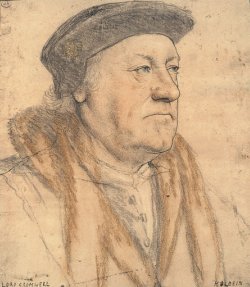
George Neville, 5th Baron Bergavanny
Born: c. 1469
Abergavanny, Monmouthshire, Wales
Died: June 14, 1535 (Age c. 66)
Bergavanny in History
As a member of the prominent Neville family, it was no surprise that George Neville would take some sort of role in politics. It would be no means clear as to which side he would take though. His great-grandfather Ralph Neville, Earl of Westmorland, was a leading Lancastrian lord while his kinsmen the Earls of Salisbury and Warwick (father and son) were loyal to the Yorkist regime during the Wars of the Roses. The latter of those three men, however, would desert the Yorkists to promote his own interests via the house of Lancaster and, although he would ultimately be killed in battle, gained the name of "kingmaker" for placing both Edward IV (a Yorkist) and Henry VI (a Lancastrian) on the throne on separate occasions. George's first political involvement seems to have been attending the coronation of the usurper king Richard III (the new Queen Anne was a relative of George's), but when Henry VII came to the throne just two years later, Neville does not seem to have fallen out of royal favor.
He took part in putting down the Cornish rebellion (1497) and was a member of the House of Lords and a frequent visitor to court. Neville did, however, attract some unwanted attention based on his association with Edmund de la Pole, Earl of Suffolk, a valid Yorkist claimant to the throne. When Suffolk was arrested and imprisoned under suspicion of treason, Neville was punished with severe fines. It does not seem as if Neville had any treasonous intent though, and the fines were revoked when Henry VII's son and heir, Henry VIII, came to the throne in 1509. Under the new king, Neville must have been a great deal happier. He was was awarded the lordship of Bergavanny (a title that had belonged to his Beauchamp ancestors) in 1512 and was created a Knight of the Garter (1513). He also seems to have shared in the interest of jousting with the new king, making the two men even closer.
Bergavanny, unfortunately, came into more trouble in the early 1520s after the execution of the Duke of Buckingham. Buckingham, whose daughter had married Bergavanny's son, had been brought up on charges of treason for supposedly listening to prophecies of the king's death without male heirs, therefore leaving the throne to him personally. Bergavanny admitted to knowing of this and was imprisoned for nearly a year, also being subjected, once again, to extremely heavy fines. Although he was ultimately released from prison and continued to play a role in royal affairs, Bergavanny was never able to truly return to his place of influence at court and was indeed looked at with suspicion by the king and many of his top advisers, including Cardinal Wolsey and Thomas Cromwell. During the last few years of his life, Bergavanny was able to partially redeem himself by supporting the king's proposed annulment to his first wife Catherine of Aragon (so he could marry Anne Boleyn and have "legitimate" offspring) and even signing the petition to the Pope, pleading for the annulment. Bergavanny died quietly in 1535 as a man in his mid-sixties. Many contemporaries and historians alike most likely believe that he was lucky to have lived that long after his close ties with two men who were ultimately executed for treason. One would say that makes him a survivor of sorts.
Bergavanny in Shakespeare
Appears in: Henry VIII
Lord Bergavanny appears briefly in Henry VIII. He is seen in the opening scene sharing his hatred of Cardinal Wolsey with his fellow lords and witnesses the arrest of the Duke of Buckingham, a man who, historically, Bergavanny had close ties to. Immediately after the duke's arrest, Bergavanny himself is arrested and imprisoned in the tower due to his close proximity to the treasonous duke. In the following scene, Buckingham's surveyor, and primary accuser, claims that Bergavannny is the duke's son-in-law. In reality, it was Bergavanny's son that held this title.
References
Hawkyard, Alasdair. ‘Neville, George, third Baron Bergavenny (c.1469–1535)’, Oxford Dictionary of National Biography, Oxford University Press, Sept 2004; online edn, Jan 2008 [http://www.oxforddnb.com/view/article/19935, accessed 24 April 2010]